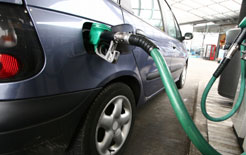SMALL business costs come under greater pressure from today (1 September) with an increase in fuel duty.
The cost per litre goes up by 2p per litre.
When VAT is included, the actual cost is 2.3p per litre. The rise will increase by another 2.5% from 1 January when VAT returns to 17.5%. The average cost of both petrol and diesel was 105p per litre in August, according to the AA August Fuel Price Report. The fuel duty increase means a litre of fuel costing between 107p-108p per litre.
In terms of price per gallon that’s roughly £4.80 a gallon of fuel.
For those traders and companies that use personal cars on business and repay business usage on the Approved Mileage Allowance Payment scheme – known as AMAPs – the fuel duty increases will further decrease the value of the 40p per mile allowance.
AMAPs provide tax free payments for business mileage in private cars for the first 10,000 miles at 40p per mile; and 25p per mile thereafter.
Matthew Tumbridge, editor of Used Car Expert and contributor to Business Car Manager, has submitted a 7000-signature to the government protesting against the rise.
Tumbridge said: “Until there are realistic and affordable green solutions for those that need to drive for work it is unforgivable that the government continues to increase the already extortionate taxes on the motorist.”
Despite the rises in fuel duty, AA analysis of the government’s latest National Travel Survey found the car accounted for 80% of distance travelled. However, average car mileage has decreased to 8,670 in 2008 from 9,700 in 1995/97 due to the cost of fuel and the general economic position.
Edmund King, AA president, commented: “The National Travel Survey shows that the car is still king. Despite the cost of fuel, we are still a nation dependent on car travel. Drivers have reduced their mileage due to economic conditions but there is still ten times the distance travelled on road rather than rail.”
Fuel Duty Rises
- The rate of fuel duty went up 2p per litre on 1 December 2008.
- A further increase of 1.84p per litre came in on 1 April 2009.
- Fuel duty rises again by 2p per litre on 1 September 2009.
- And another 1p rise is due in April 2010.
Fuel duty rises 2p per litre before VAT







